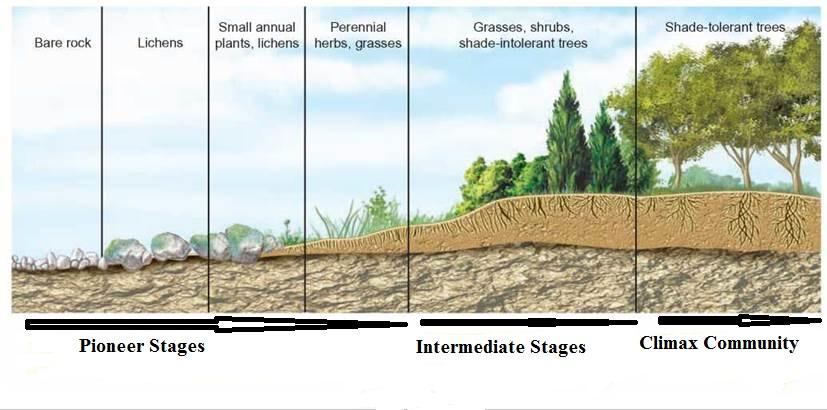
The order of succession in a lithosere or xerosere is
(A) Foliose lichen stage->Crustose lichen stage->moss stage->herb stage>shrub stage-forest stage (climax community)
(B) Crustose lichen stage->Foliose lichen stage->moss stage->herb stage>shrub stage-forest stage (climax community)
(C) Moss stage ->Foliose lichen stage-, Crustose lichen stage ->herb stage->shrub stage->forest stage (climax community)
(D) Crustose lichen stage->Foliose lichen stage->moss stage-, ->shrub stage-, herb stage->forest stage (climax community)
Answer
581.4k+ views
Hint: The process of succession originates from bare rock surfaces. The original substratum is deficient in water and lacks any organic matter, having only minerals in disintegrated untethered state.
Complete answer: The various stages in xerosere can be understood as follows:
1. The first pioneers on the barren rocks are basic organisms like crustose lichens. Gradually as little soil is formed by the activity of these lichens, next advanced forms of lichens appear namely, foliose-lichens. Further the accumulation of humus in small amounts allows the growth of mosses such as Barfula. With the mosses proliferating, soil conditions become favorable for the growth of herbs such as annual weeds. With more modification of the soil conditions shrubs start growing along with perennial wood plants like Acacia.
2. As time proceeds, this leads to full vegetation and soon results in growth of woody trees which is the forest community.

Thus, the correct answer is B. Crustose lichen stage->Foliose lichen stage->moss stage->herb stage>shrub stage-forest stage (climax community)
Note: The pioneers colonizing the barren substratum are crustose- a type of lichens, and further with ongoing seral stages succession finally terminates into a forest which is regarded as the climax community.
Complete answer: The various stages in xerosere can be understood as follows:
1. The first pioneers on the barren rocks are basic organisms like crustose lichens. Gradually as little soil is formed by the activity of these lichens, next advanced forms of lichens appear namely, foliose-lichens. Further the accumulation of humus in small amounts allows the growth of mosses such as Barfula. With the mosses proliferating, soil conditions become favorable for the growth of herbs such as annual weeds. With more modification of the soil conditions shrubs start growing along with perennial wood plants like Acacia.
2. As time proceeds, this leads to full vegetation and soon results in growth of woody trees which is the forest community.

Thus, the correct answer is B. Crustose lichen stage->Foliose lichen stage->moss stage->herb stage>shrub stage-forest stage (climax community)
Note: The pioneers colonizing the barren substratum are crustose- a type of lichens, and further with ongoing seral stages succession finally terminates into a forest which is regarded as the climax community.
Recently Updated Pages
Why are manures considered better than fertilizers class 11 biology CBSE

Find the coordinates of the midpoint of the line segment class 11 maths CBSE

Distinguish between static friction limiting friction class 11 physics CBSE

The Chairman of the constituent Assembly was A Jawaharlal class 11 social science CBSE

The first National Commission on Labour NCL submitted class 11 social science CBSE

Number of all subshell of n + l 7 is A 4 B 5 C 6 D class 11 chemistry CBSE

Trending doubts
10 examples of friction in our daily life

One Metric ton is equal to kg A 10000 B 1000 C 100 class 11 physics CBSE

Difference Between Prokaryotic Cells and Eukaryotic Cells

1 Quintal is equal to a 110 kg b 10 kg c 100kg d 1000 class 11 physics CBSE

State the laws of reflection of light

Explain zero factorial class 11 maths CBSE




